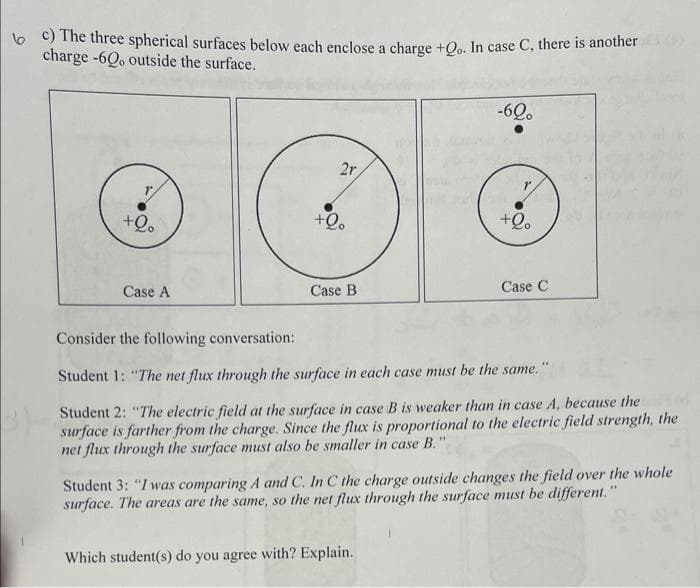Consider the following conversation: Student 1: "The net flux through the surface in each case must be the same." Student 2: "The electric field at the surface in case B is weaker than in case A, because the surface is farther from the charge. Since the flux is proportional to the electric field strength, the net flux through the surface must also be smaller in case B.' Student 3: "I was comparing A and C. In C the charge outside changes the field over the whole surface. The areas are the same, so the net flux through the surface must be different." Which student(s) do you agree with? Explain.
Consider the following conversation: Student 1: "The net flux through the surface in each case must be the same." Student 2: "The electric field at the surface in case B is weaker than in case A, because the surface is farther from the charge. Since the flux is proportional to the electric field strength, the net flux through the surface must also be smaller in case B.' Student 3: "I was comparing A and C. In C the charge outside changes the field over the whole surface. The areas are the same, so the net flux through the surface must be different." Which student(s) do you agree with? Explain.
Physics for Scientists and Engineers, Technology Update (No access codes included)
9th Edition
ISBN:9781305116399
Author:Raymond A. Serway, John W. Jewett
Publisher:Raymond A. Serway, John W. Jewett
Chapter24: Gauss’s Law
Section: Chapter Questions
Problem 24.10OQ: A cubical gaussian surface is bisected by a large sheet of charge, parallel to its top and bottom...
Related questions
Question

Transcribed Image Text:c) The three spherical surfaces below each enclose a charge +Qo. In case C, there is another
charge -60, outside the surface.
+Qo
Case A
2r,
+Qo
Case B
-60.
+Qo
Which student(s) do you agree with? Explain.
Case C
Consider the following conversation:
Student 1: "The net flux through the surface in each case must be the same."
Student 2: "The electric field at the surface in case B is weaker than in case A, because the
surface is farther from the charge. Since the flux is proportional to the electric field strength, the
net flux through the surface must also be smaller in case B."
Student 3: "I was comparing A and C. In C the charge outside changes the field over the whole
surface. The areas are the same, so the net flux through the surface must be different."
Expert Solution
This question has been solved!
Explore an expertly crafted, step-by-step solution for a thorough understanding of key concepts.
This is a popular solution!
Trending now
This is a popular solution!
Step by step
Solved in 2 steps

Knowledge Booster
Learn more about
Need a deep-dive on the concept behind this application? Look no further. Learn more about this topic, physics and related others by exploring similar questions and additional content below.Recommended textbooks for you

Physics for Scientists and Engineers, Technology …
Physics
ISBN:
9781305116399
Author:
Raymond A. Serway, John W. Jewett
Publisher:
Cengage Learning

Physics for Scientists and Engineers: Foundations…
Physics
ISBN:
9781133939146
Author:
Katz, Debora M.
Publisher:
Cengage Learning


Physics for Scientists and Engineers, Technology …
Physics
ISBN:
9781305116399
Author:
Raymond A. Serway, John W. Jewett
Publisher:
Cengage Learning

Physics for Scientists and Engineers: Foundations…
Physics
ISBN:
9781133939146
Author:
Katz, Debora M.
Publisher:
Cengage Learning
